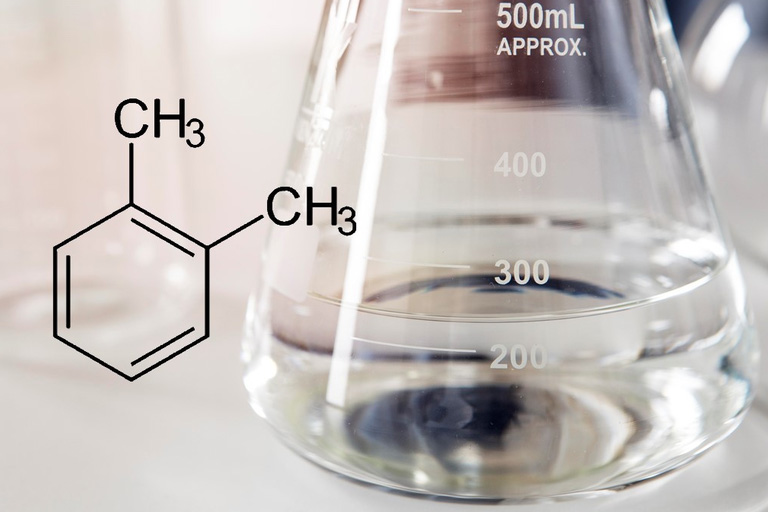
Xylene
What is Xylene?
Xylene, also known as Xylol, is a hydrocarbon that is in the form of a colorless and transparent liquid with a sweet smell and is highly flammable. It naturally occurs in petroleum, coal, and wood. In the chemical industry, xylene is produced from oil. In terms of production volume, it is one of the top 30 chemicals manufactured in the United States. Xylol is widely used as a solvent in industry and medical technology. It belongs to the aromatic compounds family, with the chemical formula (CH₃)₂C₆H₄. In the chemical industry, it is known as "dimethylbenzene" because it consists of a six-carbon ring with two attached methyl groups. There are three forms of xylene, distinguished by the position of the methyl groups on the benzene ring: ortho-xylene (o-xylene), meta-xylene (m-xylene), and para-xylene (p-xylene), which are isomers of xylene. Commercial xylene typically contains about 40-65% m-xylene, and up to 20% o-xylene, p-xylene, and ethylbenzene. When released into the environment, xylene quickly evaporates from soil and surface water into the air, where sunlight degrades it into other chemicals within a few days. It is also decomposed by microorganisms that exist in soil and water. Only a small amount of xylene accumulates in plants, fish, shellfish, and other animals that live in xylene-contaminated water. Some foods, such as meat products, eggs, bread, milk, potatoes, nuts, and green vegetables, contain small amounts of xylene or other hydrocarbons.
Uses of Xylene in Various Industries
This material is widely used both in its pure form and as a mixture of its isomers. This compound is used as a solvent in paint, printing, ink, rubber, glue, leather, and other industries.
Why is Xylene Used as an Effective Solvent in Industries? Xylene’s chemical properties allow it to dissolve other compounds quickly in water, an advantage over other solvents. For example, the paint industry utilizes this property of xylene to dissolve other solvents, making it a key choice in paint thinners and products for removing stains, residues, and adhesives. It is also found in small amounts of jet fuel and gasoline.
Uses in Histology
From the past to the present, xylene has been extensively used in tissue processing and staining in histology labs. Examining these tissues under a microscope is crucial for histopathology technicians to detect disease. In tissue processing, the tissue is placed in a medium like paraffin to enable easy slicing without damaging it. Then, the tissue that is fixed in paraffin becomes dehydrated, and as the degree of alcohol increases, water is removed from the tissue. However, alcohol does not mix with paraffin. Xylene is suitable for this process and readily mixes with paraffin. When tissues are exposed to xylene, they become transparent. Xylene also helps remove residual wax from slides, acting as an effective cleaning agent.
Use of Xylene as a Lubricant
Due to its strong lubricating properties, xylene is used in brake oil and engine oil. It is a crucial ingredient in producing various products such as adhesives, sealants, antifreeze, waxes, hair thinners, and petroleum-based motor lubricants.
Use in Concrete Sealers
As a clear, colorless liquid and an excellent solvent, xylol’s high solubility makes it an ideal choice for thin concrete sealers.
Use of Xylene in Paints and Resins
Xylene is also used in painting. It is applied in glazes, thinners for specialty paints, alkyd resins, and lacquers. It is often used as a thinner in specialty paints. This aromatic solvent is similar to toluene, but its evaporation rate is approximately five times slower.
Precautions When Using Xylene
- In case of spillage, leave the area immediately.
- Acute (short-term) inhalation exposure can irritate the eyes, throat, and nose and cause neurological and gastrointestinal effects in humans.
- Chronic (long-term) inhalation exposure may lead to central nervous system (CNS) irritation, causing headaches, dizziness, tremors, fatigue, and incoordination.
- If products containing this substance spill on the skin, remove the excess and clean the area with soap and water.
- Before working with xylene, ensure that all flammable sources, such as hot surfaces, open flames, and potential sparks, are removed.
- Post a "No Smoking" sign in areas where xylene is used before starting work.
Xylene is crucial in everyday products, such as transportation fuels, building sealers, paints, etc. It helps improve gasoline mileage, enabling people to travel further while consuming less fuel. Eliminating it from gasoline would increase gas supply demands, making gas a scarce resource, which could limit social activities. This substance helps to improve lifestyle and global economic growth. Yekta Shimi Azma Company supports you by providing high-quality, cost-effective materials to address potential challenges. For price inquiries and to purchase this substance, please visit the "Contact Us" section.

